
TOPS codes and Diagrams/Design Codes are the main ways of categorising items of rolling stock by their characteristics. TOPS codes are primarily for operational distinctions, with Designs for technical aspects. Both have a list page that can be accessed from the links in the Data sub-menu. Shown here is the TOPS list page. This has a lot of commonality to the Batches and Lots list pages, such as the inclusion of Icons and Photos, and the ability to change the View type to omit these.
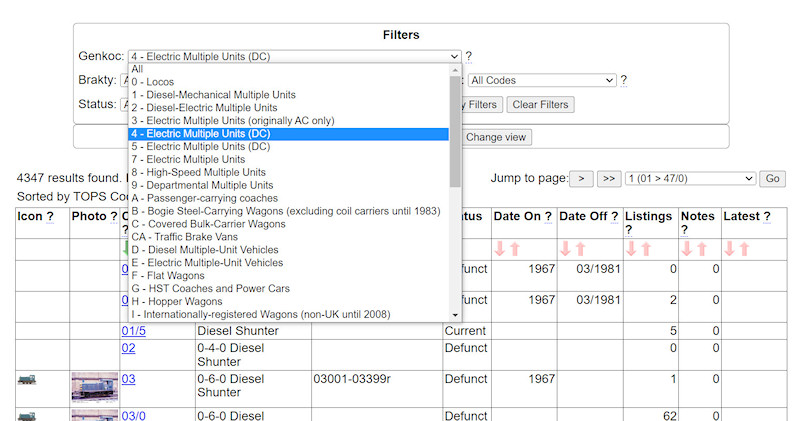
The filters on the TOPS list page are a little different. The GENKOC refers to the first letter of the TOPS code, this being the highest level of classification. For example, you could choose to view only codes starting with a 4 (these being DC EMUs).

The BRAKTY is the third letter of TOPS wagon codes and shows the brake type. Numerical TOPS class codes do not define the brake type.

The Category is my own means of grouping TOPS codes depending on what they relate to and what level of detail they show. For example, 47 is a Short Code for locos, 47/4 is a Long Code for locos. Likewise, BBA is a Short Code for wagons, while BBA-F is a Long Code. As usual, filters are only applied when you click on the
Apply Filters button.

The search function looks at both the class code and the description but is case-insensitive. Hence, searching for VAB will find several different types.

Numbers are only shown where they can be easily defined, and these are not exclusive. For example, the number range for HRA hoppers covers both HRA-I and HRA-O sub-types. Dates are provided where known but much work is still needed on these.

The last three columns show how many listings there are on LTSV-RD that relate to each TOPS code, then how many notes have been posted and when the last was posted. All columns can be sorted using the arrows.

Talking of sorting, you will see that the navigation tools change depending on the applied order. For example, if you sort the TOPS list by Description, the page jump drop-down list will show the range of descriptions that will appear on every numbered page (longer entries are truncated). This feature applies to most list pages.

Clicking on any TOPS code will open the
TOPS Details Page, as shown here. Every 'Long' TOPS code is treated as a child of a 'Short' code. For example, class 47/4 is a child of class 47. If looking at the details page for a long-code (child), a link to the short-code (parent) will be provided in the Main Details box. Other elements in the Main Details are very like those already seen for Batches and Lots.
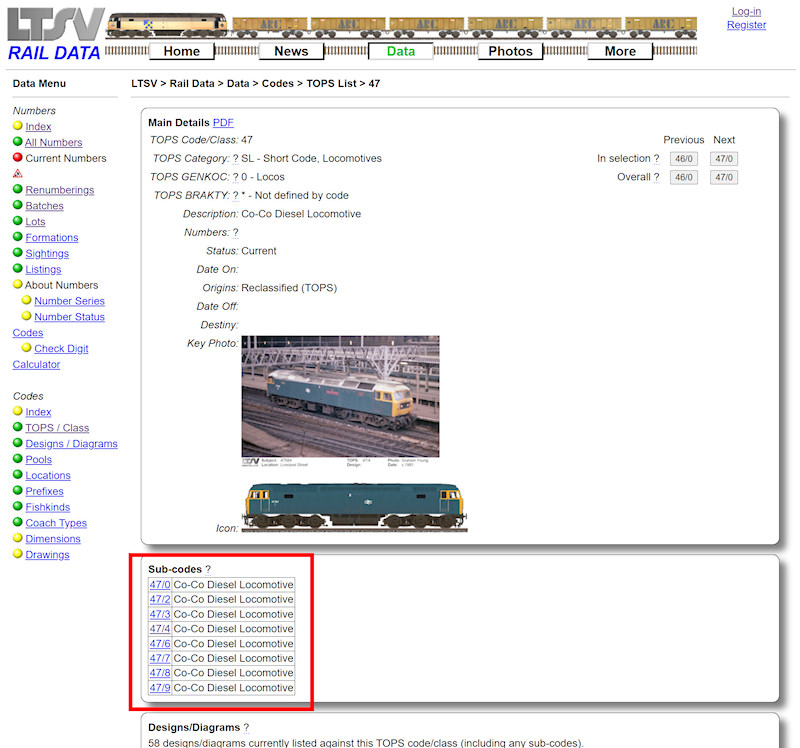
If looking at a short code (parent), any related long (child) codes will be shown (with links) in the second section, marked
Sub-codes.
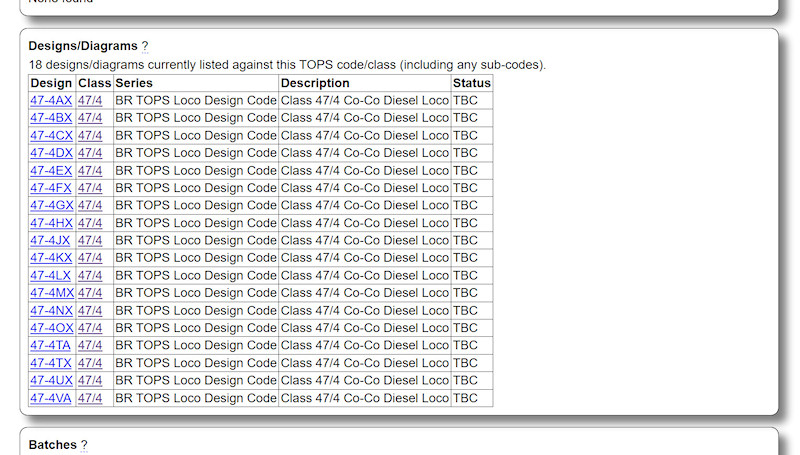
Design codes provide a finer level of classification than TOPS codes. As such, all items to any given design code should be to the same TOPS code. With locos this is self-evident. Any loco to design code 47-4AX was obviously a 47/4. With wagons this distinction is not always so clear cut. All design codes and diagrams known to relate to a given TOPS code are listed in the next section, with links. Sub-codes are included where appropriate. Hence, if looking at class 47, you will see design codes relating to classes 47/0, 47/3, 47/4 etc.
More work is needed on the data for designs. For example, as seen above, the descriptions do not yet show what the actual differences between each design are. Likewise the status information has not yet been updated (TBC stands for To Be Confirmed).
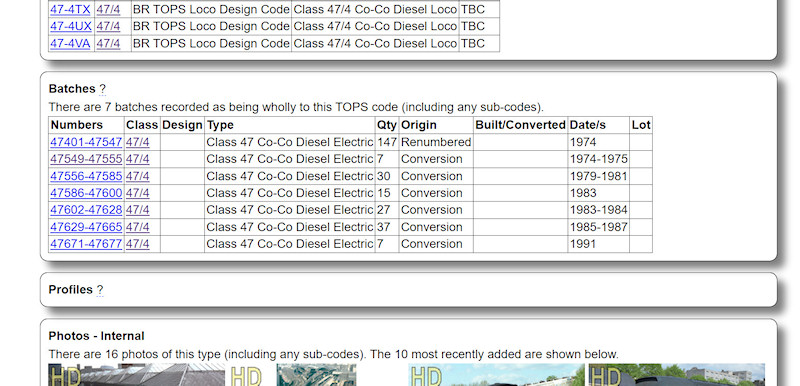
The next section lists batches that are associated with the TOPS code (including sub-codes if looking at a 'parent'). Note that only batches that were wholly to a single TOPS code will be shown. The number range of each batch acts as a link to the relevant
Batch Details page.

The Profiles, Photos and Listings sections are very like those on the Batch Details page. One difference is that only the 10 most recently added photos will be shown, with a button provided to see more.
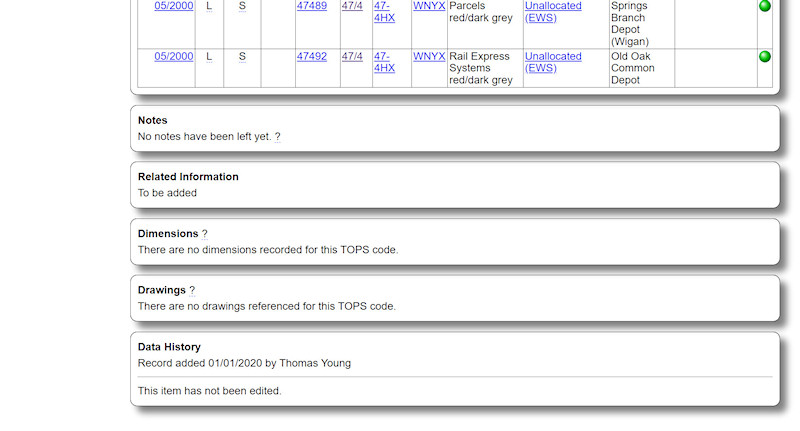
The last sections on the
TOPS Details page are again similar to those on the
Batch Details so will not be described in detail. The box marked
Related Information is for a feature that has not yet been implemented.
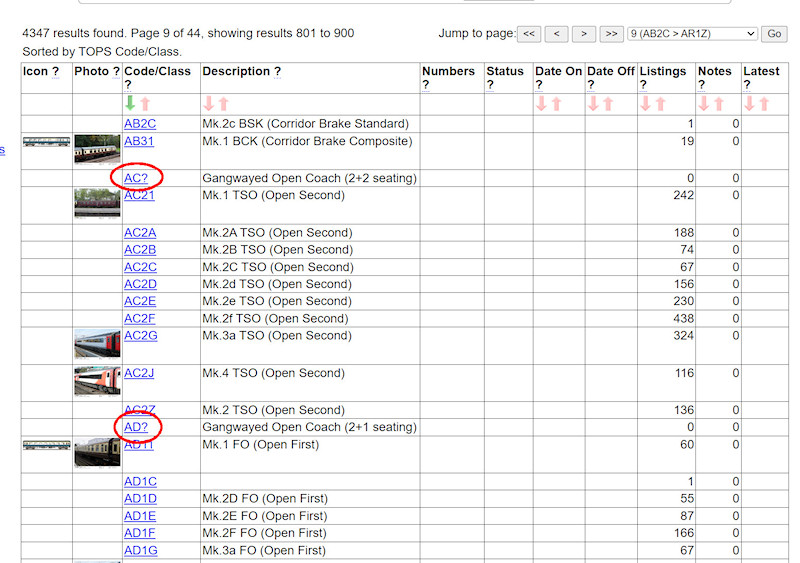
Going back to the TOPS List page, one anomaly will be apparent in the codes for coaching stock. I have added codes such as AC? and AD?. These were required for instances where the design code was known (such as AD201.0A), but the TOPS code was not.

Design codes and Diagrams are broadly similar to TOPS classes/codes, but provide a greater level of technical differentiation. They are also more varied, in as much as that a loco design code is quite different to a coach one, which is different to a wagon one. There are also different codes used for 'international' wagons, plus a variety of defunct types (such as pre-TOPS wagon diagrams). All are listed on the Designs List page.

The only really difference between this page and ones already described is the
Design Series drop-down in the Filters. You can use this to view only the designs in one of the various series.

Clicking on any individual design code or diagram will open the
Design Details page. The sections on this page are almost identical to those on the
TOPS Details page, so see that section for more information.

Dimensions and Drawings are more likely to be recorded against a design/diagram than against a batch or TOPS code. Only a few dimensions have been added so far, but most known drawings have been referenced. This is the page for BR wagon diagram 1/001. Where the drawings are on-line, a link will be provided.

 Register
Register